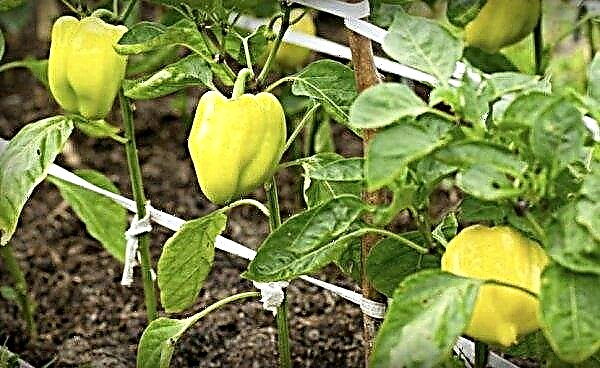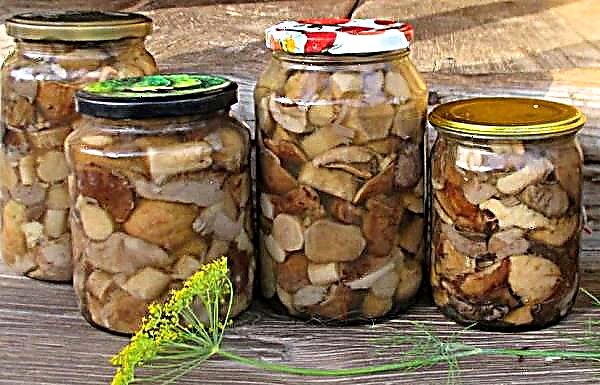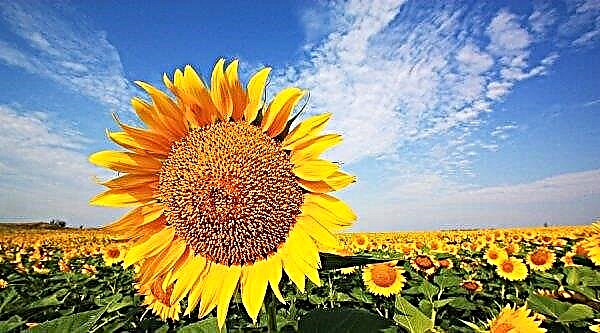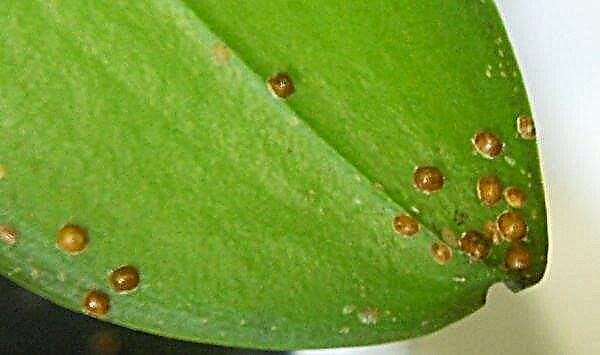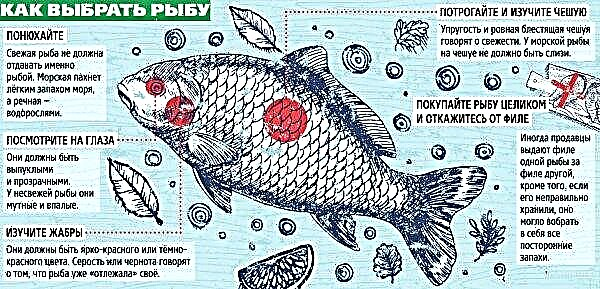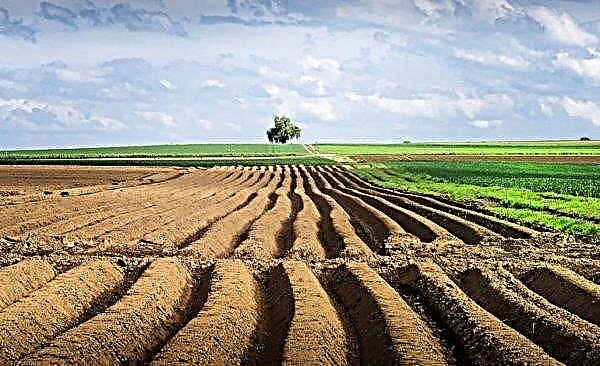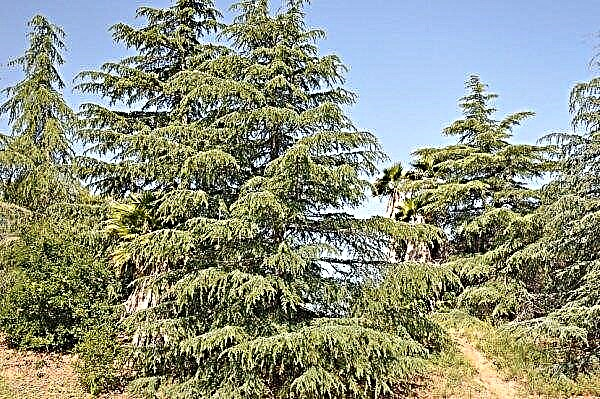Experienced gardeners practice potato cultivation in the greenhouse to harvest the popular tubers at least 2 times a year. Let us consider in more detail the features of growing tubers in a greenhouse, how to properly plant and when to start harvesting.
Did you know? Potato has been used in the world for more than 4 thousand years as a food product. For the first time, Peruvian Indians began to cultivate it, actively engaged in the cultivation of new varieties.
Planting potatoes in a greenhouse in winter
In greenhouse conditions, you can grow high-quality tasty potatoes, and if you follow the basic recommendations, the yield from 1 m² will be about 50 kg.
For growing potatoes, any kind of greenhouse can be used:
Benefits
Growing potatoes in a greenhouse can be a profitable business, as it allows for 8 months, without a break, to harvest fruits, alternating between planting periods.
- In addition, the greenhouse cultivation of tubers has many other advantages:
- consistently high productivity due to the possibility of self-regulation of growing conditions;
- simplicity of care of plantings and convenience of harvesting;
- the minimum number of pests that, when grown in the usual way, strongly affects the beds;
- maximum effect in the fight against potato diseases, thanks to the enclosed space and the high concentration of drugs inside the enclosed area;
- the possibility of growing tubers in several tiers, in large wooden pallets, which can significantly save free space.
Disadvantages
Despite the fact that greenhouse potato cultivation has a lot of advantages, it could not do without disadvantages. For example, to create a greenhouse that is suitable for use in winter, you will have to incur considerable costs for creating a heating system that will be regulated depending on environmental conditions. Greenhouse plantings require additional attention in the form of fertilizing, maintaining the recommended moisture level and observing the irrigation regularity to achieve maximum yield.
How to plant potatoes in the greenhouse in winter
To grow potatoes in a greenhouse, you must follow the basic rules of agricultural technology, choose a good variety and conduct a competent planting. Therefore, we will consider how to do this in more detail.
What varieties are best planted
The key to a good harvest is a correctly selected cultivar, since not all varieties are suitable for cultivation in greenhouses. For these purposes, it is recommended to give preference to early or early varieties that have a minimum growing season and quickly yield a crop.
Among the best varieties for greenhouses are:
- Kharkov early - high-yielding variety, characterized by the presence of white cut tubers, which are covered with a dense peel, resistant to mechanical damage. The variety is especially appreciated due to its increased resistance to high temperatures and overheating of the terrestrial part of plants;
- Priekulsky early - has tubers of rounded shape, white in cut. Shoots germinate in a short time, the variety is unpretentious to growing conditions, easily tolerates the thickening of the territory. It has a serious drawback - a strong susceptibility to late blight;

- Good luck - oval-shaped potatoes, with light flesh, grows on different types of soils, tolerates waterlogging and drought well. Often affected by late blight;

- Spark - gives a crop of large tubers of rounded shape, with a flesh of light cream color. The advantage of the variety is its high resistance to late blight, cancer and the black leg, but can be affected by scab and rhizoctoniosis.

Important! When choosing a variety, pay attention to the growth power of the bushes. For small greenhouses should be selected dwarf specimens.
Landing time
In heated greenhouses, potatoes are recommended to be planted in late August to harvest in early December or late February – early March to harvest mature tubers in late spring. Summer planting in the greenhouse is practiced only if it is possible to condition the structure, since the air temperature in the greenhouse is much higher than the outdoor temperature due to the greenhouse effect.
Unheated greenhouses are suitable for planting potatoes only in spring, since it will not be possible to maintain the required temperature in winter. To make the greenhouse as warm as possible, it is recommended to build it with a gabled roof and install in the direction from west to east. Planting of tubers is postponed for a period when daylight hours will be at least 10 hours a day.
The temperature of the soil when planting in the greenhouse should be at + 6 ° С, and it should be measured at a depth of at least 10 cm. The air temperature in the greenhouse for the normal germination of tubers should be + 18 ... + 20 ° С. In a heated greenhouse, the required indicators can be set independently, and in an unheated greenhouse, you will have to wait until the street gets warmer. Depending on the region of cultivation, the period of planting potatoes in an unheated greenhouse may be within the last days of March or early April.
In a heated greenhouse, the growing region does not matter. Tubers, while providing plantings with recommended conditions, grow well in any region. In unheated greenhouses, planting is preferable to carry out in the South and Central region.
Seat selection
Potato grows well on loose soils, and their composition is not so important, subject to regular fertilizer application. The quantity and quality of the crop directly depends on the density of the soil at the place of tuber formation, so the greenhouse should be located on sandy soil or light chernozem. Dense and heavier soils are cultivated by the introduction of river sand in large quantities.
Provided that the tubers are planted in the winter, when the plant will lack sunlight, the greenhouse should be placed in a well-lit area located on the southern side of the garden. In winter or autumn, sunny days are rare, and given that potatoes are a photophilous plant, it requires additional lighting in the form of equipping the greenhouse with artificial light sources.
Video: how to properly position a greenhouse in a plot
The windiness on the site practically does not affect the planting of potatoes, since they are protected by the design of the greenhouse. But the construction of the greenhouse in regions with strong gusts of wind should be carried out on the foundation, have a strong strong frame. For example, lightweight domed greenhouses covered with a film can greatly suffer from sudden gusts of wind and will not protect the plantings inside, and heavy polycarbonate or glass greenhouses are just right for these purposes.
Potato planting is excluded in places of high occurrence of groundwater to the surface of the soil. The problem of high occurrence of groundwater can be solved by placing a bed on a ridge or artificial elevation. It is not recommended to build a greenhouse in the lowland sections of the beds to prevent flooding in spring or during heavy rains.
Did you know? Potato is the first vegetable that has been grown in space. This event happened in 1995.
Bed preparation
Soil preparation for planting potatoes is engaged in the period when the greenhouse is not used. Depleted soil must be saturated with nutrients so that the next crop is plentiful and of high quality. In the fall, regardless of the period of planting the tubers, nitrogen (25 g) and potash (15 g) fertilizers per 1 m² are added to the soil for digging. Digging the soil is necessary to a depth of not less than 30 cm, while removing weed vegetation and residual roots.
Selection and preparation of planting material
For planting, tubers of large and medium sizes are suitable, without mechanical damage, traces of diseases and pests. When harvesting tubers for storage, it is better to select planting material that has grown under large and powerful bushes. Preparation of potatoes for planting consists in processing a solution of potassium permanganate and germinating tubers for the rapid emergence of shoots after planting in the soil.
Consider the detailed process of preparing planting material.- Initially, pure tubers are soaked in a slightly pink solution of potassium permanganate for 5 minutes to disinfect.
- After soaking, the tubers should be left in the sun for complete drying and greening, decomposing them in one layer. Green tubers do not germinate prematurely, they are not bitten by mice.
- 20 days before the planned planting dates for tubers, they are removed from the cellar or basement, laid out in a warm, well-lit room for germination. The optimum temperature for these purposes is + 13 ... + 20 ° С. So that the tubers germinate faster and do not wrinkle, they are additionally moistened with a spray once every 3-4 days.
- When the sprouts have reached a length of 1 cm - potatoes need to be planted. Longer shoots can break off and thin out, so it is important not to miss the moment and timely land.

Scheme and depth of landing
In a greenhouse, it is most convenient to plant potatoes in grooves, while maintaining a certain pattern: recesses in the soil should be made at a distance of 50 to 60 cm between rows. The depth of the grooves should be about 5-6 cm, the potatoes are laid in trenches at a distance of 20-40 cm, depending on the strength of the growth of the bush of a particular variety and the size of the planting material.
Planting and Growing Technology
Consider the step-by-step process of planting potatoes in a previously prepared garden bed.
- The tubers are laid in grooves according to the planting pattern, so that the shoots are directed upwards.
- Grooves are carefully sprinkled with moist, loose soil or humus in the soil level.
- The bed is not watered for 20 days after planting the tubers, so as not to provoke rotting of the planting material.
- The temperature in the greenhouse during planting is maintained at + 13 ... + 20 ° C.

Further care
After planting, it is recommended to immediately cover the potatoes with plastic wrap, which will create a greenhouse effect and accelerate the germination of shoots. It is necessary to cover the bed with large pieces of film, fixing it with bricks at the edges. After the appearance of the first shoots, the film is removed and no longer used.
While maintaining the recommended temperature in the greenhouse, the first shoots appear 10-12 days after planting the tubers.
At different stages of the development of the bushes, the following temperature conditions must be observed:
- shoot growth and development - + 18 ... + 20 ° С;
- the appearance of buds and the flowering period - + 22 ... + 23 ° C;
- ovary formation - + 16 ... + 18 ° С.

Be sure to make high-quality fertilizing in the soil during the process of growing potatoes - This is the only way to get an abundant tuber harvest. The best means for feeding is considered to be a solution of rotted chicken manure (cook in the ratio: 1 part of fertilizing to 15 parts of water). Watering the finished product should each bush, under the root, in an amount of 1 liter. It is necessary to feed the bushes immediately after the appearance of the first shoots.
During the flowering of bushes, top dressing based on mullein and superphosphate is used (for 10 liters of water, 2 kg of mullein and 2 tbsp. L. Superphosphate). Such top dressing is used in an amount of 1 liter for each bush, which contributes to the active formation of the ovary.Important! Potato top dressing is best done with liquid fertilizer, dry is considered less effective.
Tips from experienced gardeners
The list of tips to help grow high-quality root crops:
- To ensure that the quality of the harvested crop is at a high level, for planting, choose large tubers, without damage, traces of disease and the activity of pests.
- It is very important to observe the distance between the rows of potatoes, which will allow each bush to receive a sufficient amount of sunlight, to dry faster after watering to prevent the development of rot and mold.
- If the selected planting material is very large, you can cut the tuber into 2 parts, plant it must be cut down.
- Planting potatoes on acidic soil is carried out after neutralizing excess acidity and restoring a slightly acidic or neutral reaction. To do this, use dolomite flour, - 0.5-0.6 kg per 1 m², laying it in a layer on a substrate.

Thus, growing potatoes in a greenhouse almost all year round is very profitable for sale, since young tubers are expensive in winter. The growing process is complicated only by the construction of a heated greenhouse, and planting and caring for potatoes does not take much time and effort.
Did you know? The most expensive potato variety in the world is French La Bonnotte, grown on the island of Nurmuatier. Due to the fact that all manipulations on growing are carried out manually, and valuable seaweeds act as fertilizer, the price of fruits is 500 euros per 1 kg.





